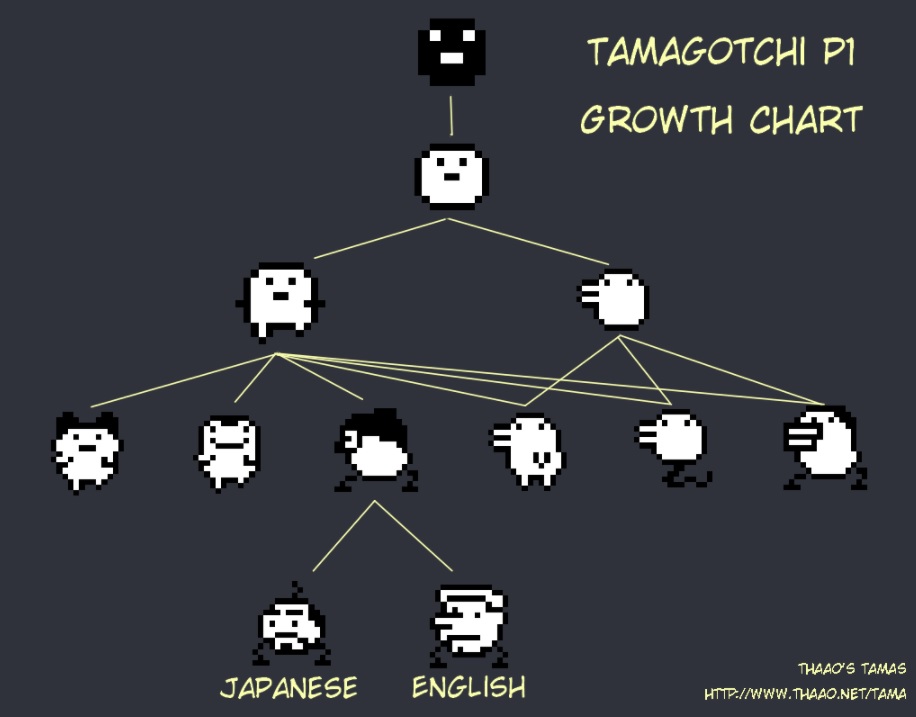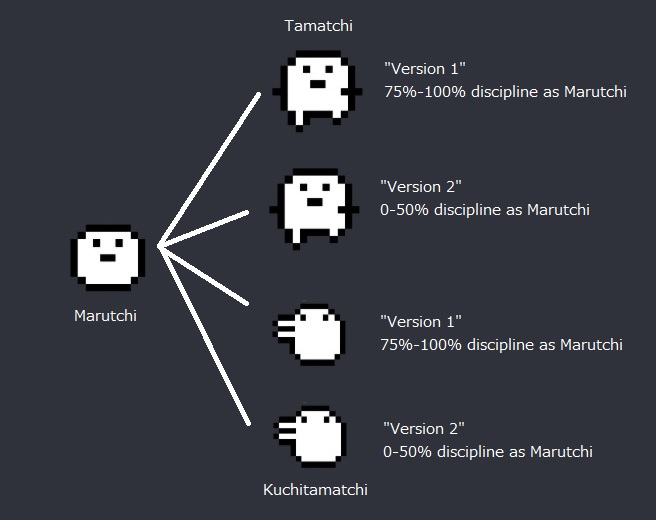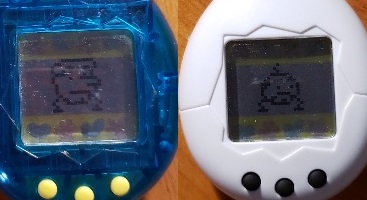Hello friends and Hive Gamers, it's been a little while. We've been in and out of the hospital (husband had a major surgery and then some complications) among other things. But all the while, I've been playing with my Tamagotchi.
Originally, I just wanted to try to get all the different character evolutions possible, taking a picture of each. It's kind of my way of "100%ing" the game. But I quickly learned that there's very little information on these little things and exactly how they work. There's quite a few 'care guides' and 'growth charts' out there, but most of them are vague, and each seems to be full of contradicting information to the others. I quickly noticed that my pets weren't evolving according to this "information" that I managed to find. I even tried looking in Japanese, where I found there was even less information.
So I had to take it upon myself to solve the mystery of Tamagotchi evolution. Over the last few months, I've been playing with eleven of Bandai's virtual pet games, doing experiments by caring for them exactly the same way except for minor differences to see if I can reverse engineer the programming through trial and error.

These little guys are surprisingly simple in some ways, and complex in others.
One of the first things I noticed by hatching multiple creatures at once was that there's no randomization in the game. It's odd because there's a clock feature, so it wouldn't have been hard to use the clock as a seed to generate random numbers. But instead, they follow a set pattern. They poop at set intervals, get sick at set intervals, and more. I even recorded the pattern for Babytchi (the baby stage which lasts 65 minutes before evolving into the child stage). The first poop is 15 minutes into its life; the first nap is after 40 minutes. Stuff like that.
The first experiment I did when I first got multiple 'Gotchis was to see the difference between feeding snacks instead of playing games to increase happiness. In all reference materials I could find, including the official instruction manuals, there's warnings that feeding too much candy is "bad" for your Tamagotchi; however, in practice, you can feed them unlimited candies without any repercussions at all. In fact, you can even overfeed them -- when their happiness and hunger are completely satisfied, you can just continue to toss candies at the little guys and they will gobble them up endlessly, unlike their meals which they refuse to eat when they are full.

But it wasn't the care mechanics that I wanted to figure out -- it was how the evolution works. And it's within that that the game gets a little more complex, while at the same time showing its simplicity.
Materials and guides online all just reference "good" and "bad" care of your Tamagotchi leading to different evolutions. Those with more specifics listed things like not letting the Tama fall asleep in poop or overfeeding snacks. But no matter what I tried, I kept getting the same few evolutions. Not to mention I couldn't even begin to figure out how to get the hidden characters.
The most popular forum for Tamagotchi has about 3 active members, who are all using the same information I am, so the specifics were lost to them as well.
I decided to try searching on Japanese websites to see if I could find any more information in the language the toy was originally published in. Surprisingly, there was even less information in Japanese, except for a Yahoo! Answers question where someone was having a similar issue to me -- no matter what they did, they got the same two evolutions. Someone suggested trying different levels of discipline, and so that was my next experiment.

And that's where everything unfolded -- after more and more trials, I learned that not only is discipline a good place to start looking, but it's one of the only two factors into which evolutions you get.
When you fail to respond to a Tamagotchi's call within 15 minutes, you accrue a "care mistake," and the game tracks how many of these you get per evolution.
The only call that doesn't cause a care mistake, though, is when Tamagotchi is misbehaving. Sometimes despite not having any immediate needs, Tama will call out and then refuse to eat or play games during its 15 minute call period. During this time, you can choose to scold your pet, which will increase its discipline.
Normally, you would assume you should always scold your pet, as that would be "good" care. But refusing to scold will not only not result in a care mistake, but will also affect the major factor in which evolution you will get.

Nothing you do in the baby stage matters at all (in fact you can just completely ignore it for an hour until it evolves), but once you hid the child stage, the game starts tracking your discipline level for your Tamagotchi. The only child form, Marutchi, can evolve into the teenagers Tamatchi or Kuchitamatchi depending on how many care mistakes you make (0 or 1 mistakes will evolve into the "better" Tamatchi, 2 or more will evolve into the "worse" Kuchitamatchi).
But the game remembers the amount of discipline your Marutchi had upon evolution. Instead of constantly referring to them as "a Tamatchi that evolved from a Marutchi with 75% or more discipline," I'll refer to them as "version 1" and "version 2" of their respective evolutions.
There are two "sets" of adults -- the "good" set (Mametchi, Ginjirotchi, and Maskutchi), and the "bad" set (Kuchipatchi, Nyorotchi, and Taraokitchi). Kuchitamatchi, the "bad" teenager, can only evolve into one of the "bad" set, but Tamatchi, the "good" teenager," has the ability to evolve into either set depending on care mistakes; more than 2 care mistakes will make it fall down into the "bad" set.
But of the three adults, which one you evolve into depends on your discipline upon evolving. "Version 1" teenagers can evolve into the "tier 1" adult with 100% discipline, into the "tier 2" adult with 75% discipline, and the "tier 3" adult with 50% or less discipline. It doesn't matter how many care mistakes you accrue for this -- even if you fail to respond to every single other call your Tamagotchi cries out, you'll still get a tier 1 adult as long as the discipline meter is full.
"Version 2" teenagers can either turn into a tier 2 adult with perfect discipline, or the tier 3 adult with any less.

What's even more surprising is that the game remembers your discipline level for two evolutionary stages as far as getting the secret character is concerned. You have to evolve Marutchi to Tamatchi with 0 discipline, then that Tamatchi into Maskutchi with 0 discipline, and then that Maskutchi will have a chance to evolve into the secret character Bill (English version) or Oyajitchi (Japanese version).
Many guides say to get the secret characters from Maskutchi you have to have "perfect" care -- no sleeping in poop, responding quickly to illness, etc. -- but it seems nothing actually matters at all as long as you keep it alive long enough to evolve having met the discipline requirements prior to the evolution into Maskutchi. Strange that the secret character would work this way, but that's how it is. I haven't yet fully tested the secret character evolution, so I don't know if you can get it with 0 discipline on your Maskutchi, but it takes 8-12 days to get to that stage, so it's a long process.
So with all of these trials over the last couple of months (and with various hospital visits and surgery complications, these little guys were the only thing keeping me sane, giving me something to focus on that was fairly low-maintenance but stable) I've come to understand pretty much exactly how the original 1997 Tamagotchi toy programming works.
While my original goal was to study and solve the evolutionary path of Tamagotchi, I still have a few things I want to figure out, like exactly how many minutes a Tama has to starve or be sick in order to die, so I can claim to know every last inner working of the toy.
And things get even more complicated with the 2018 re-release of Tamagotchi -- while it's touted as having the "original programming," it actually seems to function differently. The original Tamagotchi would misbehave exactly 4 times per evolutionary stage, giving you only those set chances to get its discipline up for your evolutions, but the new ones misbehave all the time, giving you more opportunity to fine-tune your discipline to get the evolutions you want. But what's even more surprising is that feeding snacks matters now -- in fact, if you feed too many, your Tamagotchi will even die. Even in the child stage! So my next goal is to figure out exactly how the rereleases work. But for now, I'm happy to have "solved" the original toy.
I compiled all this information into the ultimate care guide and explanation site, which I'm still working on (I decided to add exactly what times each evolution wakes up and goes to bed, which means I have to go back and get all the evolutions over again) and will update with new information about the rereleases as I find them. I'm also going to include version differences (as with regional releases and rereleases, there are actually nine variations on the original toy).
Basically, my little experiment to see if I could reliably get my favorite character evolutions in my Tamagotchi House turned into a quest to write the most comprehensive guide to the virtual pet that exists -- sadly something that seems to be lacking from the internet until now.
Collecting and playing with the toys sparked a new passion for me -- I now want to collect all the different kinds of virtual pets and solve them all. There are actually quite a few sequels to Tamagotchi, and the franchise is still running with the current "Tamagotchi On" device featuring a full color screen and a breeding system that gives you customized pets based on their parents' attributes. It even connects to a phone app to allow more play options!
But my focus is probably going to stay on nostalgic toys -- in addition to the rereleases of the original pet, I want to play around with some of the Japanese-exclusive follow-ups like Angelgotchi and Devilgotchi. Though my most anticipated item to collect and play is the Tamagotchi found the in Forest (which almost was released in the west as "Tamagotchi Garden"), where you raise alien bug creatures and have to maintain the proper temperature for them to evolve healthily from their cocoons.
But those will have to wait until I have a bit of spare cash to dish out for more toys (hospital bills are always fun). Hope you enjoyed reading! Let me know if you have any memories with virtual pets as a kid!
That's really surprising that theres no RNG. Maybe it was easier to program it without randomness? IDK, but it sounds like you fully solved that thing lol
This information is not entirely correct, although it is the most accurate that I have seen published, I attached my document where I have reverse engineered p1 and reference is made to the original patent.
https://github.com/formatcom/tamatama/blob/master/Tutorial%20Tamagotchi%20P1.pdf